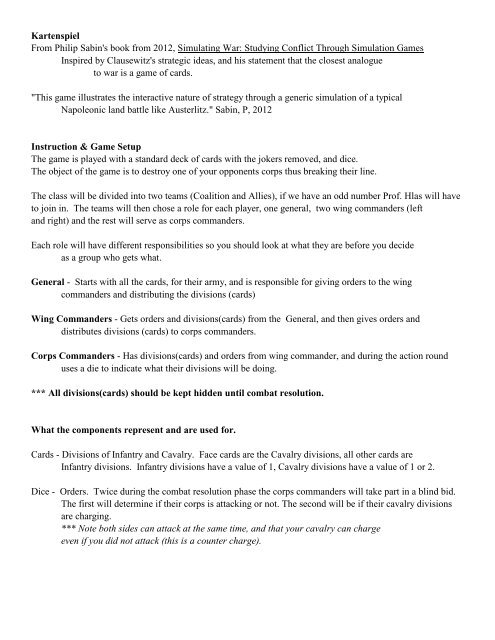Kartenspiel From Philip Sabin's book from 2012, Simulating War ...
Kartenspiel From Philip Sabin's book from 2012, Simulating War ...
Kartenspiel From Philip Sabin's book from 2012, Simulating War ...
You also want an ePaper? Increase the reach of your titles
YUMPU automatically turns print PDFs into web optimized ePapers that Google loves.
<strong>Kartenspiel</strong><br />
<strong>From</strong> <strong>Philip</strong> <strong>Sabin's</strong> <strong>book</strong> <strong>from</strong> <strong>2012</strong>, <strong>Simulating</strong> <strong>War</strong>: Studying Conflict Through Simulation Games<br />
Inspired by Clausewitz's strategic ideas, and his statement that the closest analogue<br />
to war is a game of cards.<br />
"This game illustrates the interactive nature of strategy through a generic simulation of a typical<br />
Napoleonic land battle like Austerlitz." Sabin, P, <strong>2012</strong><br />
Instruction & Game Setup<br />
The game is played with a standard deck of cards with the jokers removed, and dice.<br />
The object of the game is to destroy one of your opponents corps thus breaking their line.<br />
The class will be divided into two teams (Coalition and Allies), if we have an odd number Prof. Hlas will have<br />
to join in. The teams will then chose a role for each player, one general, two wing commanders (left<br />
and right) and the rest will serve as corps commanders.<br />
Each role will have different responsibilities so you should look at what they are before you decide<br />
as a group who gets what.<br />
General - Starts with all the cards, for their army, and is responsible for giving orders to the wing<br />
commanders and distributing the divisions (cards)<br />
Wing Commanders - Gets orders and divisions(cards) <strong>from</strong> the General, and then gives orders and<br />
distributes divisions (cards) to corps commanders.<br />
Corps Commanders - Has divisions(cards) and orders <strong>from</strong> wing commander, and during the action round<br />
uses a die to indicate what their divisions will be doing.<br />
*** All divisions(cards) should be kept hidden until combat resolution.<br />
What the components represent and are used for.<br />
Cards - Divisions of Infantry and Cavalry. Face cards are the Cavalry divisions, all other cards are<br />
Infantry divisions. Infantry divisions have a value of 1, Cavalry divisions have a value of 1 or 2.<br />
Dice - Orders. Twice during the combat resolution phase the corps commanders will take part in a blind bid.<br />
The first will determine if their corps is attacking or not. The second will be if their cavalry divisions<br />
are charging.<br />
*** Note both sides can attack at the same time, and that your cavalry can charge<br />
even if you did not attack (this is a counter charge).
The classroom will be divided down the middle with each role having and assigned area.<br />
Coalition Army Allies Army<br />
VI Corps I Corps<br />
Left Wing V Corps II Corps Right Wing<br />
IV Corps III Corps<br />
General General<br />
III Corps IV Corps<br />
How to play the game.<br />
Right Wing II Corps V Corps Left Wing<br />
I Corps VI Corps<br />
Arrows indicate the directions orders and divisions (cards) can move during the game.<br />
After the setup is done, the umpire will call for the orders phase to begin.<br />
Orders Phase I - Each team's general and wing commanders meet and discuss what will happen during the<br />
turn. The general will give each wing commander their orders (attack with all corps, attack with one,<br />
or defend with all. The general will also distribute all, some, or none of the army's divisions (cards).<br />
Each team has 2 minutes for this phase.<br />
Orders Phase II - Each wing commander will meet with the corps commanders they have responsibility for<br />
and give them orders for the turn and distribute all, some, or none of their divisions to each<br />
commander.<br />
Each team has 2 minutes for this phase.<br />
Combat Phase - All corps commanders will now participate in at least one blind bid. If they wish to attack<br />
they will reveal their die in the first bid. If either opposing corps reveals a die (i.e. is attacking),<br />
then they will have a second blind bid. The second blind bid will be to determine if their cavalry<br />
divisions will charge (or counter-charge if defending). Revealing their die in the second bid,<br />
indicates that their cavalry is charging.<br />
Note: Charging cavalry is worth 2 points for combat resolution, however it must also take any losses<br />
that their side has to take for the combat.<br />
Combat Resolution - If either corps opposite one another has chosen their die, then there is combat.<br />
If neither side reveals a die then there is no combat and play moves to the next set of opposing corps.<br />
When combat takes place and the second blind bid has finished, both side add up their combat<br />
value. Each card counts as 1 point unless it is a cavalry division (face card) and is charging in<br />
which case it will be worth 2 points but must take any losses that the combat results call for their<br />
side to take.
Combat Resolution cont.<br />
Compare both sides combat value for each corps and determine the losses that must be taken by each side:<br />
If your corps is attacking you take 1 loss, unless the corps you are attacking has fewer then two<br />
divisions.<br />
If your corps is attacking and your combat value is greater then the opposing corps they will take<br />
1 loss.<br />
If your corps is attacking and your combat value is 2 times greater then the opposing corps combat<br />
value, then they will take 2 losses.<br />
If combat value is equal or the non-attacking corps has the great value, then no losses other than the<br />
loss for attacking will be taken.<br />
Remember that if you charged with your cavalry all your losses must come <strong>from</strong> them first.<br />
After all combats have been resolved check for victory. The game is won if any of your opponent's<br />
corps have no cards left.<br />
If victory has not been achieved the game continues with all rounds happening in order again.<br />
*Things to remember or consider*<br />
Once you distribute a division it will stay where you send it, it can not come back. So if you want to be able<br />
reinforce a wing or corps you will need to keep a reserve (i.e. hold some cards back).<br />
If you leave a corps with only 2 divisions it can be defeated (you lose) if your opponent attacks with 4 or<br />
more of their own divisions.<br />
Hide you cards so that your opponent does not know what you have until it is time to resolve combat.



